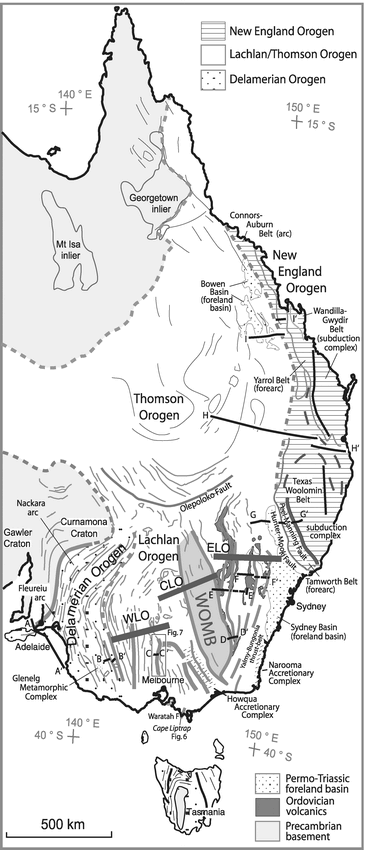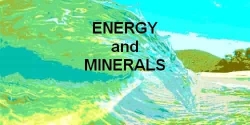Metamorphic Rocks
Metamorphic rocks
source https://flexiblelearning.auckland.ac.nz/rocks_minerals/rocks/metamorphic.htmlhttps://geomaps.wr.usgs.gov/parks/rxmin/rock3.html
http://serc.carleton.edu/research_education/equilibria/classicalthermobarometry.html
http://csmres.jmu.edu/geollab/Fichter/MetaRx/Barrovian.html
https://opentextbc.ca/geology/chapter/7-3-plate-tectonics-and-metamorphism/
http://www.geo.fu-berlin.de/en/v/geolearning/mountain_building/metamorphism/contact_metamorphism/index.html
https://australianmuseum.net.au/types-of-metamorphism
http://www.sandatlas.org/mylonite/
Metamorphic textures
Types of metamorphism
Regional metamorphism
Contact metamorphism
Dynamic metamorphism
Retrogressive metamorphism
What are metamorphic facies?
Metamorphic belts in
Australia
see
also E-Learning - Metamorphism...
see
also Petrology - Metamorphism...
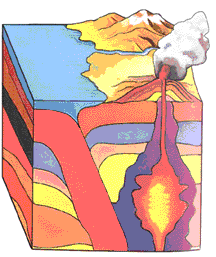
"Click on any rock name to see any image and description...""
Metamorphic rocks are "derived" rocks that is to say they are made from pre-existing igneous, sedimentary and metamorphic rocks.
Heat and/ or pressure form metamorphic rocks.
In being formed metamorphic rocks do not melt but only recrystallise.
Metamorphism is the alteration of pre-existing rocks in the solid state due to changes in temperature and pressure.
Under increasing temperature and / or pressure existing minerals become unstable and break down to form new minerals.
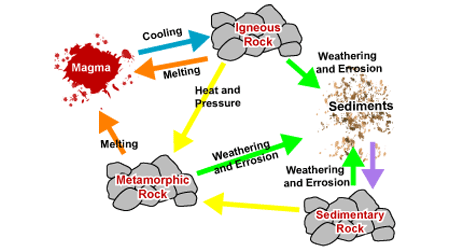
Metamorphic textures
The two distinctive metamorphic textures are: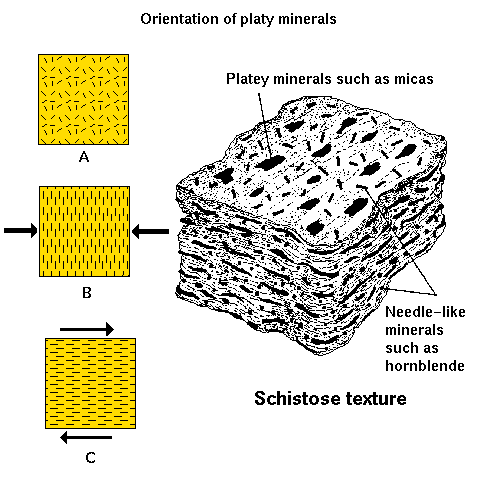
- Foliation - Foliation forms when pressure squeezes the flat or elongate minerals within a rock so they become aligned. These rocks develop a platy or sheet-like structure that reflects the direction that pressure was applied in. Slate, schist, and gneiss (pronounced 'nice') are all foliated metamorphic rocks.This represents a distinct plane of weakness in the rock. Foliation is caused by the re-alignment of minerals when they are subjected to high pressure and temperature. Individual minerals align themselves perpendicular to the stress field such that their long axes are in the direction of these planes (which may look like the cleavage planes of minerals). Usually, a series of foliation planes can be seen parallel to each other in the rock. Well developed foliation is characteristic of most metamorphic rocks. Metamorphic rocks often break easily along foliation planes.
- Granular - Non-foliated metamorphic rocks do not have a platy or sheet-like structure. There are several ways that non-foliated rocks can be produced. Some rocks, such as limestone are made of minerals that are not flat or elongate. No matter how much pressure you apply, the grains will not align! Another type of metamorphism, contact metamorphism, occurs when hot igneous rock intrudes into some pre-existing rock. The pre-existing rock is essentially baked by the heat, changing the mineral structure of the rock without addition of pressure.This describes a metamorphic rock consisting of interlocking equant crystals (granules), almost entirely of one mineral. A granular texture is developed if a rock's chemical composition is close to that of a particular mineral. This mineral will crystallise if the rock is subjected to high pressure and temperature. A if granular texture is characteristic of some metamorphic rocks. Note: As the grade of metamorphism increases (more temperature and pressure), both crystal size and the coarseness of foliation increase. Therefore, gneiss represents more intense metamorphism (or a higher grade) than does schist.
- Some fine-grained metamorphic rocks, e.g. schist, have larger crystals present. These crystals are called porphyroblasts. Porphyroblasts represent minerals that crystallise at a faster rate than the matrix minerals. Garnet is a common porphyroblast mineral.
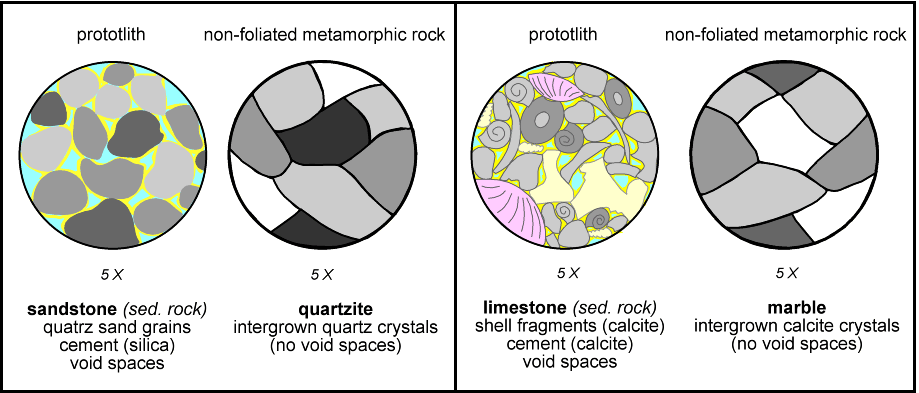
"Click on any rock name to see and image and description..."
| Grain Size --> | Fine Grained | Medium Grained | Coarse Grained |
|---|---|---|---|
| Poorly foliated | Hornfels | Marble, Quartzite | Marble, Quartzite |
| Well foliated | Slate | Schist | Gneiss |
| Well foliated and sheared | Mylonite, Soapstone | Mylonite, Schist | Augen gneiss |
Some more metamorphic textures
Schistose texture:Strong foliation, or alignment of grains, particularly micas, in coarse-grained metamorphic rocks.
Phyllitic texture:
Strong foliation in fine-grained metamorphic rocks.
Granoblastic texture:
is an equigranular texture in which crystals adopt a polygonal morphology with grain triple junctions of approximately 120 degrees. The formation of granoblastic textures occurs to minimise the combined surface energy of phases within a rock.
Porphyroblastic texture:
Metamorphic texture consisting of large grains in a finer grained matrix.
Types of Metamorphism
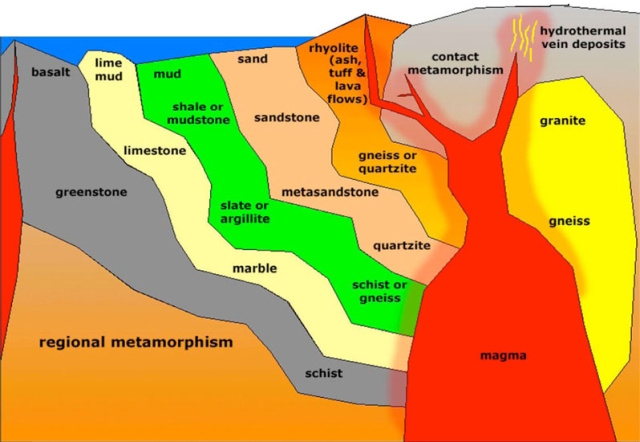
Regional Metamorphism
The rocks are subjected to tectonic forces ("pulling apart" = tension or "pushing together"=compression) to change the local rocks. Examples include: schist , slate, and gneiss.Most metamorphic rocks occur in fold mountain belts or cratonic areas. Such rocks cover large areas of the Earth's crust and are therefore termed regional metamorphic rocks. They arise by the combined action of heat, burial pressure, differential stress, strain and fluids on pre-existing rocks. The resulting rocks are always deformed (as a result of the differential stress) and commonly exhibit folds, fractures and cleavages. Large amounts of granitic intrusions are also associated with regional metamorphic rocks. Regional metamorphism covers a wide range of temperature and pressure conditions from 200° C - 750° C and 2 kbar - 10 kbar (or 5 km - 35 km depth). There are three metamorphic facies within regional metamorphosed rocks, which from lowest to highest grade are:
- Greenschist: can be further divided into chlorite and biotite zones. The term greenschist gets its name from the rocks themselves as many rocks of this facies are grey-green in colour and have a schistose (parallel arrangement of platy minerals) texture.
- Amphibolite: can be further divided into the garnet and staurolite zones. The term amphibolite gets its name from the most common constituent minerals of this facies, minerals of the amphibole group.
- Granulite: can be further divided into the kyanite and sillimanite zones. The term granulite reflects the most common texture of these rocks - granular.
In some parts of the world, geologically young (Cenozoic and Mesozoic) fold mountain belts contain sequences of metamorphosed fine-grained sedimentary rocks and basic volcanic rocks that contain unusual blue amphiboles. These rocks are commonly schistose, may have a characteristic blue colour, and are termed blueschists. These form at low temperature but high pressure conditions in the collision zones of subducting slabs. Amphibolite is the name of a facies and a dominant rock
When subducting oceanic slabs are dragged down to depths exceeding 50 kilometres, the basalt is metamorphosed at very high pressures to form a dense rock with the same bulk chemical composition but different mineralogy (dominantly pyroxene and garnet) and texture. These rocks are called eclogites.
Contact Metamorphism
involves metamorphosis through heating by an intruding plutonic body.
Example: hornfels.At shallow
depths within the crust (usually less than 6 km) the heat sources
responsible for contact metamorphism are bodies of hot magma (e.g. igneous
intrusions) which raise the temperature of the surrounding rocks. These
thermal affects are usually restricted to the contact zones of the
intrusions, hence the term contact metamorphism. However, sometimes hot
fluids are released from the intrusions and penetrate the enclosing rocks
along fractures and produce contact metamorphic zones. Determining factors
governing the extent of contact metamorphism are the size of the intrusion
and its temperature. Basic magmas are much hotter than acid magmas and hence will have a greater thermal effect. Also, a large intrusion contains much more heat than a small dyke-like body and its effect on the surrounding country rocks will be much greater and more widespread.Country rocks surrounding large, hot bodies of magma are heated, initiating mineral reactions and forming new minerals. Rocks adjacent to thin dykes and sills are simply baked and hardened and do not experience any great mineralogical and/or textural changes. Large plutons give rise to contact aureole zones within which the country rocks are thermally metamorphosed, with those closest to the plutons experiencing more heat than those further away (hence they have a higher metamorphic grade). As large plutons take millions of years to cool down, the surrounding country rocks also stay hot for tens of thousands of years allowing chemical reactions to continue to completion.
The metamorphic facies produced by contact metamorphism in order of increasing grade are as follows:
- Albite epidote hornfels
- Hornblende hornfels
- Pyroxene hornfels
- Sanidinite
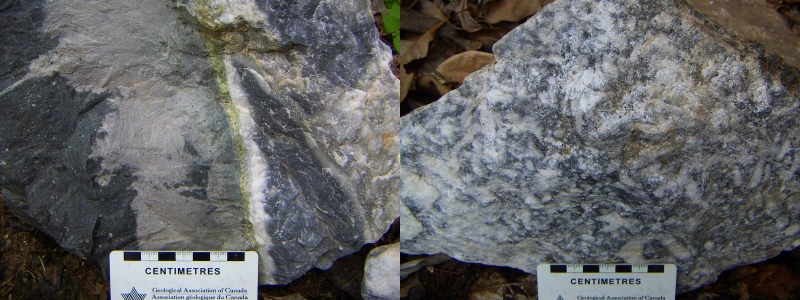
An example of contact metamorphism from Chillagoe Queensland.
Steps in this contact metamorphism from right to left:
- you can just make out the shapes of bivalve fossils in limestone recrystallising and converting to marble as they approach a dolerite / diabase dyke
- the green minerals at the contact are "calc-silicates"
- you can see calcium from the limestone has entered the dolerite and contaminated it along the contact
- the contact metamorphism in the area has resulted in commercial deposits of copper, gold and marble
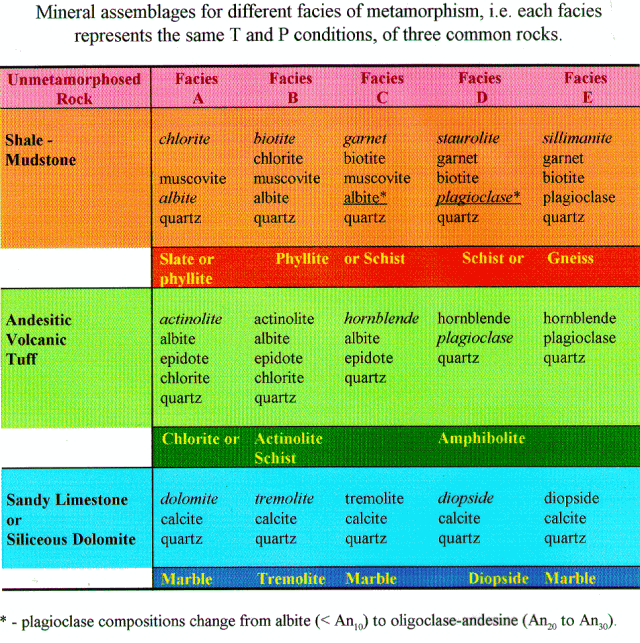
Dynamic metamorphism
Dynamic metamorphic rocks are restricted to narrow zones adjacent to faults or thrusts. The high shear stresses associated with faults and thrusts crush the adjacent rocks. The rise in temperature is produced by frictional heat generated within the fault zone. The high shear stresses may be short-lived or long-lived depending on the activity of the fault or thrust. Dynamic metamorphism involves high shear stress, high pressure, high strain, high fluid partial pressure and variable temperature. In many instances, water plays a fundamental role.Crushed rocks in fault zones are known as fault breccias which consist of angular fragments of the country rock in a matrix of crushed or powdered rock, cemented by quartz and/or calcite. Fluids move easily along fault zones between grain boundaries and through cracks and fissures. These fluids are able to transport large amounts of silica, carbonates and other minerals in solution.
Pseudotachylite is a fault-zone rock which is black and glassy. It usually occurs as narrow dykes and veins and forms by frictional melting of the country rock. Mylonites are partially recrystallised rocks with a pronounced foliation that are produced by intense shearing during large-scale movements along faults and thrusts. The different rock types produced by dynamic metamorphism vary with depth from the surface as, with increasing depth, both the surrounding pressure and temperature increase
Retrogressive metamorphism
Many metamorphic rocks contain evidence of retrograde mineral changes, that is, alteration of higher grade minerals into lower grade ones. Many of these changes involve hydration and are the result of a decrease in temperature and increase in the activity of water. Retrograde metamorphism is normally produced by repeated regional metamorphism where a lower grade episode is superimposed on a higher grade one. Most retrogressive events are probably just a consequence of the metamorphic system cooling down after peak metamorphism has been reached (i.e. the system has to cool down with time and as the region undergoes uplift with time, both pressure and temperature are dramatically reduced). The secondary minerals produced during retrogressive metamorphism generally occur as fibrous fringes around, inclusions within, and pseudomorphous grains after, the higher grade metamorphic minerals. A good example of retrogressive metamorphism is the occurrence of serpentinites. These form by generally low temperature hydration of ultramafic rock (containing minerals composed chiefly of magnesium and iron), commonly at subduction zones.
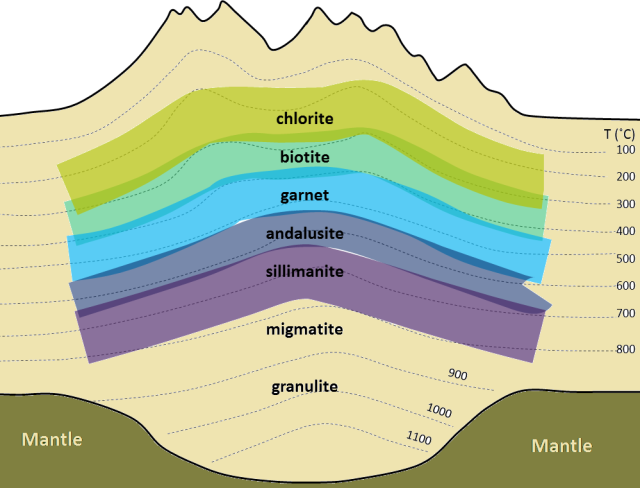
What are metamorphic facies
Approaches used in identification of metamorphic rocks:- Metamorphic Facies - A metamorphic facies is a set of
metamorphic mineral assemblages that were formed under similar
pressures and temperatures.
The assemblage is typical of what is formed in conditions corresponding to an area on a two dimensional graph of temperature vs. pressure metamorphic rocks are classified according to the conditions under which they recrystallised.
These "key minerals" may only be present in small proportions, and in many cases are difficult to recognise in hand specimen. - Degree of Recrystallisation - useful in the field or for hand specimens, is based upon the of the original minerals, and so grain size and the degree of foliation are important.
- Deformation - looking for structures that indicate
deformation, such as folding (often shown as crenulations or small
crumpled folds), and small fractures or faults
These observations are useful in determining what type of rock was present before metamorphism
An important skill if you are looking for a mineral deposit.
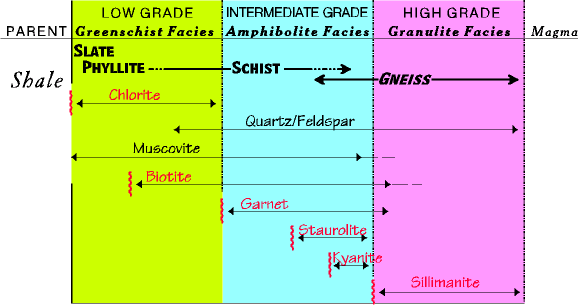
Three metamorphic facies shown "key minerals" in red
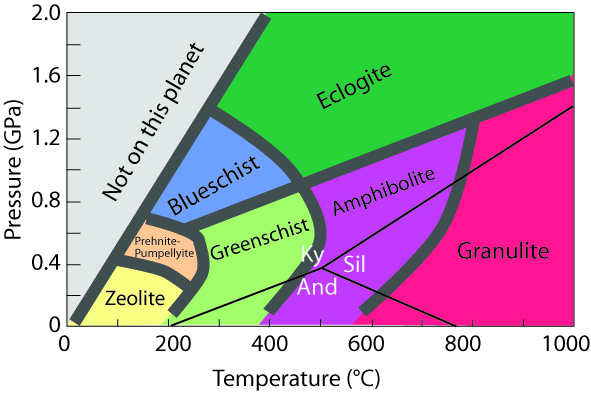
Pressure / temperature graph
Metamorphic belts in Australia
The geology of eastern Australia is dominated by a number of these fold mountain belts. The largest are the Lachlan and New England fold belts. Both of these fold belts contain relatively low-grade regional metamorphic rocks, along with numerous granitic intrusions. The New England Fold Belt contains small amounts of blueschists and eclogites that formed in the collision zones of subducting slabs. These fold belts have formed over hundreds of millions of years by plate tectonic processes.
